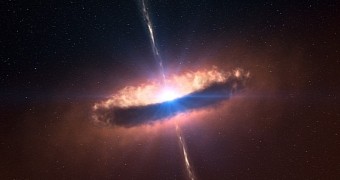In a recent paper in the journal Science, researchers with the Helmholtz-Zentrum Dresden-Rossendorf (HZDR), a research laboratory in Germany, offer an explanation for the formation of so-called cosmic jets, which astronomers describe as positively mind-blowing.
As noticeable in the image accompanying this article, cosmic jets, otherwise known as astrophysical jets, are basically ginormous rays of matter that protrude into space. In some cases, they can measure several light-years in length.
Having spent quite a lot of years peering into the makeup of the our universe, scientists found that such cosmic jets can originate from the center of black holes, quasars, i.e. compact regions in the center of a massive galaxy, and protostars, i.e. large masses that forms before a proper star is born.
However, it took the scientific community quite a while to figure out how and why such spear-like cosmic formations come into being. By the looks of it, it's magnetic fields that cause young stars to birth cosmic jets and send them shooting through space.
Creating teeny-tiny stars in the laboratory
As part of their investigation into how and why protostars birth cosmic rays, the HZDR researchers first hit a run-of-the-mill plastic sample with laser light. This set the electrons at the core of the sample in motion, essentially causing the plastic to turn into conductive plasma.
“On a small scale, the plasma represents a young star's accumulation of matter,” Professor Thomas Cowan explained in a statement. “Think of it as a sort of rapidly expanding hot cloud of electrons an ions,” the researcher went on to detail.
Having created this plasma, the researchers exposed it to a very powerful pulsed magnetic field. In response to this treatment, the plasma ended up focusing and forming a hollow center. Eventually, a teeny-tiny beam similar to the cosmic jets observed in space emerged from it.
Writing in the journal Science, the specialists behind this research project explain that, in just 20 nanoseconds, their lab-made plasma formed jets similar to the ones very young stars that are not yet done properly forming take about 6 years to birth.
Interestingly enough, the anatomy of the beams created in laboratory conditions by the HZDR scientists was found to match that of the cosmic jets documented in space. Thus, regardless of their size, the structures were all found to pack hot spots caused by a crossing over of streams of particles.
“X-ray measurements of actual jets show these features at the exact same points as our true-to-scale plasma model in the lab,” Director of the HZDR Institute of Radiation Physics and study co-author Thomas Cowan wished to stress.
How space research can help with cancer treatment
Now that they know that the cosmic jets documented shooting out protostars are caused by magnetic fields, the scientists behind this investigation argue that it might be possible to use the findings of this research project to develop better treatment options for cancer.
More precisely, the researchers imagine using pulsed magnetic fields such as the ones they employed in their experiments to birth very thin proton beams that can help make radiation therapy a wee more efficient. Still, it's important to note that it will probably be a while until this technology becomes available to the general public.

 14 DAY TRIAL //
14 DAY TRIAL //